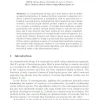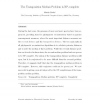49 search results - page 9 / 10 » Genome Rearrangements and Sorting by Reversals |
COCOON
2005
Springer
14 years 1 months ago
2005
Springer
In computational biology, gene order data is often modelled as signed permutations. A classical problem in genome comparison is to detect conserved segments in a permutation, that ...
TCS
2011
13 years 2 months ago
2011
During the last years, the genomes of more and more species have been sequenced, providing data for phylogenetic reconstruction based on genome rearrangement measures, where the m...
RECOMB
2007
Springer
14 years 7 months ago
2007
Springer
In the past decade, genome rearrangements have attracted increasing attention from both biologists and computer scientists as a new type of data for phylogenetic analysis. Methods ...
WABI
2010
Springer
13 years 5 months ago
2010
Springer
The double cut and join (DCJ) operation, introduced by Yancopoulos, Attie and Friedberg in 2005, allows one to represent most rearrangement events in genomes. However, a DCJ cannot...
RECOMB
2010
Springer
13 years 5 months ago
2010
Springer
In comparative genomics studies, finding a minimum length sequences of reversals, so called sorting by reversals, has been the topic of a huge literature. Since there are many mini...


